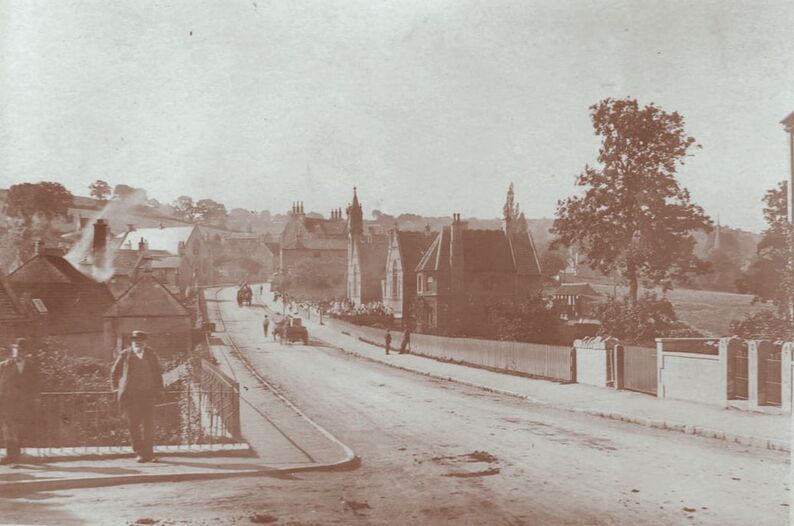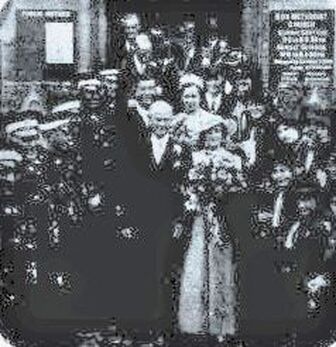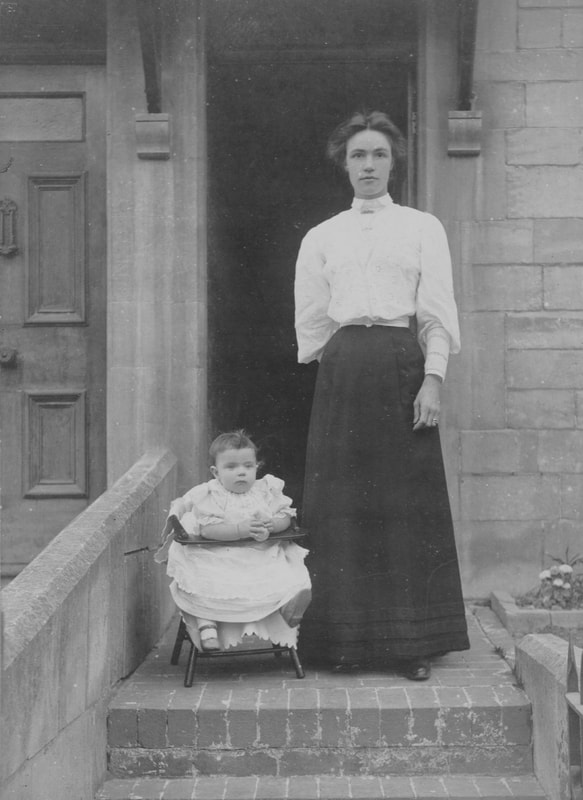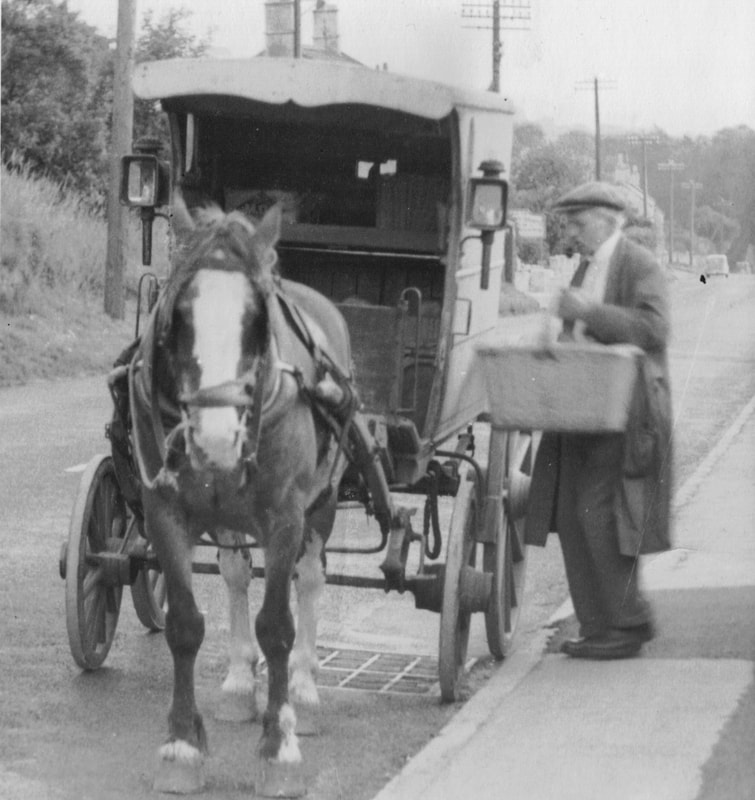Residents in Central Box: Mill Lane, Fairmead View and the High Street
Alan Payne and Varian Tye Additional research John Whitfield May 2019
Alan Payne and Varian Tye Additional research John Whitfield May 2019
Naming a brand-new house can be difficult if there is no obvious description that makes it unique. Sometimes people resort to compound words that relate to the location and which sound old. This sort of description might be Ashcroft or Maycot referring to the trees which might (or might not) be found in the area.
Fairmead View is a compound description but not an obvious one. Its origins come from the old name of Manor Farm as Mead Farm. This was used when Mead Villas were built on land to the west in 1906. The view offered by the Fairmead Terrace overlooked Upper Mead (now called the Upper Rec), the most fertile and flat meadow owned by the farm, hence the Fair component. But the name Fairmead View wasn’t obvious to others and in the 1950s it still needed identification, being known as the entrance at the Red Gate on the main road (A4), seen in the picture, above (courtesy Anna Grayson).
In the article on Central Box, we saw how Fairmead View was part of a planned series of enclosures nibbling away at the boundaries surrounding the farmland. The development of the terrace was part of a larger housing project by the Bath Stone Firms to build 42 cottages in 1899. The project was partly on green field land (now called Fairmead View and High Street) and partly to redevelop older properties at Woodstock and Mill Lane. The properties planned weren’t a single development but were built piecemeal – if built at all. We can trace this through historic maps of the area which you can see on the Know Your Place website. The first edition (1844 to 1888) shows only Woodstock Cottages; the second edition (1894 to 1902) shows the terrace at Mill Lane, the first rank to be constructed, but not Fairmead View or the High Street. However, the 1901 census refers to the terrace of properties on Bath Road, now named High Street, which were presumably only recently completed but not Fairmead View.
The 1901 three terraces which were completed (excluding rebuilding Woodstock Cottages) were listed in the 1911 census and they are also on the Ordnance Survey of 1921 to 1943. So, we need to consider each rank separately.
Fairmead View is a compound description but not an obvious one. Its origins come from the old name of Manor Farm as Mead Farm. This was used when Mead Villas were built on land to the west in 1906. The view offered by the Fairmead Terrace overlooked Upper Mead (now called the Upper Rec), the most fertile and flat meadow owned by the farm, hence the Fair component. But the name Fairmead View wasn’t obvious to others and in the 1950s it still needed identification, being known as the entrance at the Red Gate on the main road (A4), seen in the picture, above (courtesy Anna Grayson).
In the article on Central Box, we saw how Fairmead View was part of a planned series of enclosures nibbling away at the boundaries surrounding the farmland. The development of the terrace was part of a larger housing project by the Bath Stone Firms to build 42 cottages in 1899. The project was partly on green field land (now called Fairmead View and High Street) and partly to redevelop older properties at Woodstock and Mill Lane. The properties planned weren’t a single development but were built piecemeal – if built at all. We can trace this through historic maps of the area which you can see on the Know Your Place website. The first edition (1844 to 1888) shows only Woodstock Cottages; the second edition (1894 to 1902) shows the terrace at Mill Lane, the first rank to be constructed, but not Fairmead View or the High Street. However, the 1901 census refers to the terrace of properties on Bath Road, now named High Street, which were presumably only recently completed but not Fairmead View.
The 1901 three terraces which were completed (excluding rebuilding Woodstock Cottages) were listed in the 1911 census and they are also on the Ordnance Survey of 1921 to 1943. So, we need to consider each rank separately.
Mill Lane Developed 1899 - 1901
We get an indication of living conditions in Mill Lane in September 1910 when the owners, the Bath & Portland Stone Firms, were requested to meet with the newly-created Sanitary Committee at the Rural District Council (RDC).[1] The councils had been created in 1894 with the specific role of protecting the health of residents because they took over many responsibilities from the old Poor Law Unions through sub-committees such as the Sanitary Authority Committee. The Firms had built the cottages without internal sanitation, just garden earth closets and no soakaways. The RDC considered this to be contrary to its bye-laws.[2] The Stone Firms prevaricated suggesting to the Box sub-committee that the problem was the way the facilities were being used – hinting that residents did not clear out the earth pits and bury the contents often enough.[3] Nothing was resolved and, in the end, the matter was deferred until after the Second World War.[4] The problem for the Mill Lane properties was that the area was low-lying and without spring water to flush away the residue, unlike Fairmead View and the High Street developments. The situation of the cottages was marginally improved when Mill Road was lowered as lorries from the Mill kept scraping the road surface. You can still see the different levels in the stone wall near the A4 road.[5]
Of the eight original household heads in Mill Lane in 1901, most were quarry employees: two freestone sawyers, one freestone chopper, a stone mason, one railway wagon-maker and one blacksmith both employed by the Bath Stone Firms, and just two in other employment. The same proportions existed in 1911. By 1939 this predominance of stone workers had gone and only two of the eight heads of household worked in the trade.
We get an indication of living conditions in Mill Lane in September 1910 when the owners, the Bath & Portland Stone Firms, were requested to meet with the newly-created Sanitary Committee at the Rural District Council (RDC).[1] The councils had been created in 1894 with the specific role of protecting the health of residents because they took over many responsibilities from the old Poor Law Unions through sub-committees such as the Sanitary Authority Committee. The Firms had built the cottages without internal sanitation, just garden earth closets and no soakaways. The RDC considered this to be contrary to its bye-laws.[2] The Stone Firms prevaricated suggesting to the Box sub-committee that the problem was the way the facilities were being used – hinting that residents did not clear out the earth pits and bury the contents often enough.[3] Nothing was resolved and, in the end, the matter was deferred until after the Second World War.[4] The problem for the Mill Lane properties was that the area was low-lying and without spring water to flush away the residue, unlike Fairmead View and the High Street developments. The situation of the cottages was marginally improved when Mill Road was lowered as lorries from the Mill kept scraping the road surface. You can still see the different levels in the stone wall near the A4 road.[5]
Of the eight original household heads in Mill Lane in 1901, most were quarry employees: two freestone sawyers, one freestone chopper, a stone mason, one railway wagon-maker and one blacksmith both employed by the Bath Stone Firms, and just two in other employment. The same proportions existed in 1911. By 1939 this predominance of stone workers had gone and only two of the eight heads of household worked in the trade.
|
Mr Albert Edgar Toy (1868 - 1954), a railway wagon-maker, was a very well-known Box person, who lived at 1 Mill Lane. Albert trained at the Bristol Wagon Works and came to Box in 1895 to work for the Stone Firms until 1946. His contribution to the Methodist Church was enormous, a founder trustee who helped build the church in the High Street.[6] He was a church sidesman, secretary of the Sunday School and devised a candle-game which the church used for fund raising for thirty years.[7] Albert loved the outdoors and was a life-long advocate of cycling, walking and fishing. It wasn’t only Albert who was well-known in the village; his daughter Grace Toy, Captain of the Box Guides, married John King, leader of the Box Ambulance Brigade.[8] Their wedding in the summer was one of the few bright points in 1937 as war loomed.
|
|
High Street (known as Bath Road) Developed about 1901 The name Bath Road is curious for a rank of houses to the east of the village, rather than the west. The name was intended to direct travellers from London to go on the main road rather than down the Market Place. But it probably caused some confusion and a change of name was needed. To level the road down from Box Hill, a hump in the road was levelled off resulting in part of the road being raised (compared to the ground level at The Lycetts) and another part being lowered (compared to the level of Stoney Steps). The height of the newly-christened High Street won general approval and was adopted. As with Mill Lane, most of the first tenants in the High Street were connected with the quarry trade. But the rank was more obvious than Mill Lane and attracted a wider market. In 1911 one tenant was an insurance agent, one a flour mill worker and another was a widow who worked as a dressmaker. Left: 6 The High Street in about 1918 showing Rhoda Giles Martin (nee Spencer) and Evelyn Martin (courtesy Phil Martin) |
Fairmead View Built about 1907
By the time that Fairmead View was built, the properties were made available to anyone who could afford the rent. In 1911 Benjamin Drew (born 11 December 1875 at Lund, Wiltshire and died 1955), employed as a baker and his wife (Emily Edith Alice Smith from Middlehill, Box) lived at 22 Fairmead View (then called Mill Lane). They had been married in 1902 and this was their first home. In the 1920s and 1930s, Ben was self-employed and sold bread and cakes from his horse and cart until the couple rented a cottage Mead House near the traffic lights which ran from the Devizes Road to the High Street, next to the steep alleyway down to The Bear.
By the time that Fairmead View was built, the properties were made available to anyone who could afford the rent. In 1911 Benjamin Drew (born 11 December 1875 at Lund, Wiltshire and died 1955), employed as a baker and his wife (Emily Edith Alice Smith from Middlehill, Box) lived at 22 Fairmead View (then called Mill Lane). They had been married in 1902 and this was their first home. In the 1920s and 1930s, Ben was self-employed and sold bread and cakes from his horse and cart until the couple rented a cottage Mead House near the traffic lights which ran from the Devizes Road to the High Street, next to the steep alleyway down to The Bear.
|
Bill Cooper Remembered Ben Drew’s Bakery
The bakery itself comprised a large stone building with a vast gas-fired oven into which numerous loaf-shaped tins were thrust via a long steel pole with a pocket on the end. The loaves were of three sizes, very long, large and a cottage-style loaf. Also, there was a lardy cake on request! Opposite the oven was a large table for mixing the dough and, whenever anyone called, Mr Drew was always there kneading the dough. In the upper yard was a stable with a roof for the delivery horse and Ben's cart, which all entered into the yard through double wooden gates. Joey, Ben’s cart horse, grazed the steep field opposite the Upper Ley track. He was fetched in the early afternoon to pull the bread delivery cart on the various rounds. The cart itself had a roof and altogether was a rather high-class affair, more a chaise than a cart, with a bold sign on each side, B DREW, BAKER, all very professionally written. Right: Ben Drew and Joey at the top of Box Hill (courtesy Mark Jaworski) |
Ben’s daily routine was always the same, loaves in the oven, fetch Joey the horse, feed him, do nearby local deliveries by basket and bicycle, load up the cart, then embark on the allotted delivery route, leaving his wife to manage the shop. This routine continued until Ben became very elderly and frail and seemed to be increasingly fatigued, and he sold the round in the late 1940s.
Box Police Station
At 24 Fairmead View in 1911 lived a policeman, Thomas Carpenter. This is interesting because it was the same house as Joseph Gape, Box’s village constable from 1931 to 1936, who succeeded PC Teddy Carter at the Box police station in the 1920s. The Wiltshire Constabulary kept the lease of the Fairmead View property for their needs as a local police station before they bought The Keep, London Road, as the local office.
Joseph Gape had been a police officer since 1910, serving for 25 years until his retirement in December 1936. Typical comments of the man referred to a very efficient officer who carried out his duties quietly and in order.[9] When he retired, the family continued to live in Box and, after the advent of the Second World War, Joe Gape served as a War Departmental Clerk (Security Office). His time in Box was full of small incidents, almost a Dixon of Dock Green scenario. In 1932 he prosecuted a cyclist for being towed down Box Hill by a lorry. In the same year there was a theft of wood from a shed owned by G J Kidston worth £1.11s.6d.[10] These were much simpler times than our own.
Perhaps the most complicated was a curious incident in 1934 when a bus driver stopped his vehicle to extinguish a car fire outside the Northey Arms. The bus driver was knocked over by a car and Joe was called to give first aid and sort out the rights and wrongs.[11] It was Joe Gape’s son who later made a miraculous return from Dunkirk during World War 2.
Woodstock Not Developed
Woodstock Cottages were considerably older than the surrounding area but they appear to have fallen into disrepair. In 1901 two of the cottages were occupied by widows and one was vacant. Possibly the Stone Firms had hoped to see the tenants out before redeveloping the area but never got around to it.
Box Police Station
At 24 Fairmead View in 1911 lived a policeman, Thomas Carpenter. This is interesting because it was the same house as Joseph Gape, Box’s village constable from 1931 to 1936, who succeeded PC Teddy Carter at the Box police station in the 1920s. The Wiltshire Constabulary kept the lease of the Fairmead View property for their needs as a local police station before they bought The Keep, London Road, as the local office.
Joseph Gape had been a police officer since 1910, serving for 25 years until his retirement in December 1936. Typical comments of the man referred to a very efficient officer who carried out his duties quietly and in order.[9] When he retired, the family continued to live in Box and, after the advent of the Second World War, Joe Gape served as a War Departmental Clerk (Security Office). His time in Box was full of small incidents, almost a Dixon of Dock Green scenario. In 1932 he prosecuted a cyclist for being towed down Box Hill by a lorry. In the same year there was a theft of wood from a shed owned by G J Kidston worth £1.11s.6d.[10] These were much simpler times than our own.
Perhaps the most complicated was a curious incident in 1934 when a bus driver stopped his vehicle to extinguish a car fire outside the Northey Arms. The bus driver was knocked over by a car and Joe was called to give first aid and sort out the rights and wrongs.[11] It was Joe Gape’s son who later made a miraculous return from Dunkirk during World War 2.
Woodstock Not Developed
Woodstock Cottages were considerably older than the surrounding area but they appear to have fallen into disrepair. In 1901 two of the cottages were occupied by widows and one was vacant. Possibly the Stone Firms had hoped to see the tenants out before redeveloping the area but never got around to it.
In the next issue we focus on the sale of the properties by the Bath and Portland Stone Firms in 1934, including why they made the disposals and the extent of properties they owned in the area. We have an article about the history of Woodstock in a subsequent issue.
References
[1] The Wiltshire Times, 11 June 1910
[2] The Wiltshire Times, 9 July 1910
[3] The Wiltshire Times, 3 September 1910
[4] The Wiltshire Times, 12 October 1946
[5] Contributed by Alan Clench
[6] The Wiltshire Times, 17 April 1954
[7] The Wiltshire Times, 8 December 1951
[8] The Wiltshire Times, 24 July 1937
[9] The Wiltshire Times, 2 January 1937
[10] Bath Chronicle and Herald, 18 June and 22 October 1932
[11] Bath Weekly Chronicle and Herald, 5 May 1934
[12] JH Chandler Wiltshire Record Society, Dissenters Meeting House Certificates 1689-1852, p.90
[13] Bath Chronicle and Weekly Gazette, 20 October 1864
[1] The Wiltshire Times, 11 June 1910
[2] The Wiltshire Times, 9 July 1910
[3] The Wiltshire Times, 3 September 1910
[4] The Wiltshire Times, 12 October 1946
[5] Contributed by Alan Clench
[6] The Wiltshire Times, 17 April 1954
[7] The Wiltshire Times, 8 December 1951
[8] The Wiltshire Times, 24 July 1937
[9] The Wiltshire Times, 2 January 1937
[10] Bath Chronicle and Herald, 18 June and 22 October 1932
[11] Bath Weekly Chronicle and Herald, 5 May 1934
[12] JH Chandler Wiltshire Record Society, Dissenters Meeting House Certificates 1689-1852, p.90
[13] Bath Chronicle and Weekly Gazette, 20 October 1864



